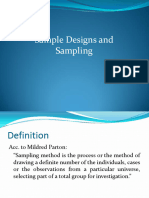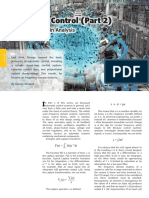Chapter 2 Statistical Data and Sampling
Uploaded by
Kent Ivan Delpaz CamposChapter 2 Statistical Data and Sampling
Uploaded by
Kent Ivan Delpaz CamposThe Statistical Data and Sampling
Framework of Statistical Analysis
Planning
Collection of Data
Organization and Presentation of Data
Analysis of Collected Data
Interpretation and Conclusions
Recommendations based on Conclusion
Nature of Data
Classification of Data
Primary -- gathered directly from an original source by the
analyst or researchers.
Ex. Interview, Questionnaires, diaries, etc.
Secondary -- gathered from published or unpublished materials
that have been previously obtained by other individuals or
agencies.
Ex. From books, journals, newpapers, registration of
births, deaths, marriages. etc.
Advantage of primary data is accuracy, reliability and relevance.
Qualitative Data measures quality, an attribute or a characteristics on
each experimental unit
produced data that can be categorized according to similarity
and differences in kind
Ex. house type (single, detached or duplex); eye color;
sex/gender; civil status; level of management; educational
attainment; etc.
Quantitative Data -- measures a numerical quantity or amount in
each experimental unit.
Ex. Interest Rate; height; weight; temperature, scores in a test;
etc.
Classification of Quantitative Data:
Discrete Variable - a finite or countable number value
Continuous Variable can assume infinitely many values
Ex. numbers or orders per day; number of
telephone calls
Ex. Height; weight; time; volume
Methods of Data Collection
Interview Method -- a direct method of investigation
Ways of conducting interviews:
Telephone
Computer (on-line)
Personal
provides more consistent and more precise information
it is inexpensive in terms of questionsl prepared
necessary for in particular situations, such patients suffering
from strokes.
Disadvantages:
time consuming
uncomfortable for some persons
limited field coverage
Analyzing information gathered difficult to quantify
requires training
Questionnaire
Registration
Observation
Experimentation
Classification of Measurable Data
Nominal Scale
lowest level of measurements
consist of labels or names to classify observed elements
Ex. Gender Distribution of 100 Adults; Marital Status
Ordinal or Ranking Scale
elements can be arranged in some meaningful kind of natural
orders
Ex. Academic performance of Students (poor, fair, good, very
good and outstanding); size of 100 shirts (small; medium, large,
XL)
is QUALITATIVE VARIABLE
Interval Scale
elements can be differentiated according to characteristics; can
be ranked or order -- with zero point origin
Ex. Temperatures in degrees celcius; mental ability scores;
blood pressures
A quantitative variable
Ratio Scale
Considered as the highest level of measurement
have order property; unit of measurement; meaningful
differences (interval); but have a FIX ZERO Point ORIGIN.
Ex. Temperature in degree Kelvin; volume; time; length
A quantitative variable
Sampling
Sampling is the act, process, or technique of selecting suitable sample,
or representative part of a population.
Sample is a set of n objects to be selected from the population
Slovins formula is often used to calculate the sample size:
Margin of error (e) is the probability of committing an error.
While (100-e)% is the probability of getting the correct result.
Note: the lower the margin of error, the larger is the required
sample size.
Example1: In a population of 22,000 students enrolled at Saint Louis
University in a particular semester, what sample size is needed to get
an accurate result for a study using a margin of error:
1%
n = 22000/(1+22000(0.01)^2)
n = 6875
n = 22000/(1+22000(0.05)^2)
n = 393
5%
2.5%
n = 22000/(1+22000(0.025)^2)
n = 1492
Another Formula:
Example: Using 95% confidence level, what is the sample size needed
to estimate the mean serum cholesterol level of a population within
9.8mg/dl of the true mean and it is given that = 20?
n =((1.96)*(20)/9.8)^2
n = 16
Sampling Technique:
Probability Sampling -- selection using randomized mechanism.
Simple random sampling -- individual in the population has
equal and independent chance of being selected.
also called lottery or raffle sampling
used to eliminate biased
Systematic Random Sampling
a good substitute of simple random sampling
Divide the population size by the sample size and round
off the result to the nearest whole number, use the
resulting number to start with and as interval in the
selection.
Example1: In a population of 200 items in a production
process.
N = 200 ; e=5% ; n = 133
Number = 200/133 = 2
2nd , 4th , 6th , 8th . . . . . . .
N = 200 ; e=5% ; n = 40
Number = 200/40 = 5
5th , 10th , 15th , 20th . . . . . . .
Stratified Sampling
Selects simple random samples from each of the subpopulations
or strata of the population.
Example1: Given the following data, determine the share of
each stratum if the desired sample size, n is 1500
Stratum (Age
Range)
30-39
20-29
10-19
Populatio
n
1500
4500
9000
15000
% Share
0.1
0.3
0.6
Sample Size (n),
% share x Total Sample
Size
0.10 x 1500 = 150
0.30 x 1500 = 450
0.60 x 1500 = 900
n = 1500
Example2: A researcher wishes to conduct a survey among the
students from the different departments. He wishes to find out
how many from each department is needed to represent the
population. Suppose the distribution of the population is as
follows:
Department
Number of Students
Business
1500
%
Share
0.32
Administration
Management
Finance
Entrepreneurs
hip
Culinary Arts
1200
850
850
200
0.25
0.18
0.18
0.04
Sample
Share
0.32 x 369 =
117
93
66
66
16
150
N = 4750, e=0.05
Slovins Formula, n =
369
0.03
1.00
12
369
Cluster Sampling (Area Sampling)
Cluster in any group of persons or experimental units having
similar characteristics.
Useful when population under consideration are scattered
geographically -- a simple random samples of groups is
selected.
Example: getting samples from socio-economic groups in a
province like a community clustered to high-income, middleincome and low-income classes.
Multi-stage Sampling:
Uses several stages or phases in getting random samples from
the general population.
Very useful in nation-wide surveys: Example National Survey
Random Sampling of Regions, then
Random Sampling of provinces, then
Random Sampling on municipality level
Non-probability Sampling -- selection of samples is solely determined
by rules or guidelines set by the researcher/investigator. Very prone to
bias.
Purposive Sampling pick sample based on certain criteria and
subjects that satisfy the criteria.
Quota Sampling -- example, choice of the actual persons is left
to the interviewers own convenience and preference (not
random). Example a QUOTA of 50 samples.
Convenience Sampling used when really impossible to select a
random sample (selection is at the researchers convenience).
Example: finding out demand for a new product in a store.
Judgement Sampling -- samples are picked based on the opinion
of someone who is familiar with the relevant characteristics of
the population. Example: small sample from a highly
heterogeneous population.
Snowball Sampling useful when population are inaccessible or
hard to find.
Example: investigator begins by identifying someone who
meets the criteria for inclusion in the study.
Summation Notation: X = 2, 5, -3, 4, 1, 1
x = 2 + 5 3 +4 + 1 + 1 = 10
x2 = 4 + 25 + (-3)2 + 16 +1 + 1 = 56
( x )2 = (2+5-3+4+1+1)2 = 100
3x
= 3 (2+5-3+4+1+1) = 3 (10) = 30
You might also like
- Business Data Analytics Students-07-Sampling PDFNo ratings yetBusiness Data Analytics Students-07-Sampling PDF50 pages
- 2006 - Philosophy, Methodology and Action ResearchNo ratings yet2006 - Philosophy, Methodology and Action Research43 pages
- Introduction To Management Chapter One Rift Valley UniversityNo ratings yetIntroduction To Management Chapter One Rift Valley University31 pages
- Chapter 7 Sampling and Sampling DistributionsNo ratings yetChapter 7 Sampling and Sampling Distributions44 pages
- Research Methods: Sampling & PopulationNo ratings yetResearch Methods: Sampling & Population48 pages
- Research Methods For Business & Management: Summer Semester - 2020/2021 Module Fourteen SamplingNo ratings yetResearch Methods For Business & Management: Summer Semester - 2020/2021 Module Fourteen Sampling27 pages
- Presentation On Sampling: Group MembersNo ratings yetPresentation On Sampling: Group Members42 pages
- Sampling: Advanced Statistics Masters in Government ManagementNo ratings yetSampling: Advanced Statistics Masters in Government Management16 pages
- Types of Sampling Probability and Non ProbabilityNo ratings yetTypes of Sampling Probability and Non Probability46 pages
- SIA 2101 - Lecture 8 - Sampling PopulationNo ratings yetSIA 2101 - Lecture 8 - Sampling Population58 pages
- SAMPLING DISTRIBUTION 1autorecovered 310922401106253550No ratings yetSAMPLING DISTRIBUTION 1autorecovered 31092240110625355092 pages
- Measurement and Scales and Selecting Sampling 21102022 095103amNo ratings yetMeasurement and Scales and Selecting Sampling 21102022 095103am21 pages
- Sampling Techniques for College Research StudentsNo ratings yetSampling Techniques for College Research Students38 pages
- Pending Transactions For Inventory Period CloseNo ratings yetPending Transactions For Inventory Period Close6 pages
- Automatic Control (Part 2) : Frequency Domain AnalysisNo ratings yetAutomatic Control (Part 2) : Frequency Domain Analysis4 pages
- Subscription-Management Case Study - Solunus Inc FinalNo ratings yetSubscription-Management Case Study - Solunus Inc Final1 page
- Influence The Psychology of Persuasion - Graphic0% (1)Influence The Psychology of Persuasion - Graphic1 page
- CodeVisionAVR Revision History 20051208No ratings yetCodeVisionAVR Revision History 2005120820 pages
- Questionnaire For Retailers VAS Value Added Services 1. WhichNo ratings yetQuestionnaire For Retailers VAS Value Added Services 1. Which3 pages
- 2006 - Philosophy, Methodology and Action Research2006 - Philosophy, Methodology and Action Research
- Introduction To Management Chapter One Rift Valley UniversityIntroduction To Management Chapter One Rift Valley University
- Research Methods For Business & Management: Summer Semester - 2020/2021 Module Fourteen SamplingResearch Methods For Business & Management: Summer Semester - 2020/2021 Module Fourteen Sampling
- Sampling: Advanced Statistics Masters in Government ManagementSampling: Advanced Statistics Masters in Government Management
- SAMPLING DISTRIBUTION 1autorecovered 310922401106253550SAMPLING DISTRIBUTION 1autorecovered 310922401106253550
- Measurement and Scales and Selecting Sampling 21102022 095103amMeasurement and Scales and Selecting Sampling 21102022 095103am
- Automatic Control (Part 2) : Frequency Domain AnalysisAutomatic Control (Part 2) : Frequency Domain Analysis
- Subscription-Management Case Study - Solunus Inc FinalSubscription-Management Case Study - Solunus Inc Final
- Questionnaire For Retailers VAS Value Added Services 1. WhichQuestionnaire For Retailers VAS Value Added Services 1. Which

























































































